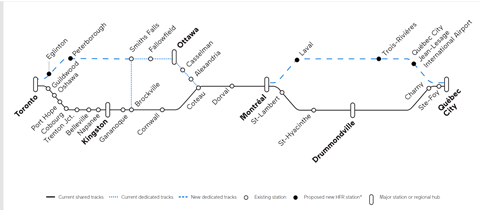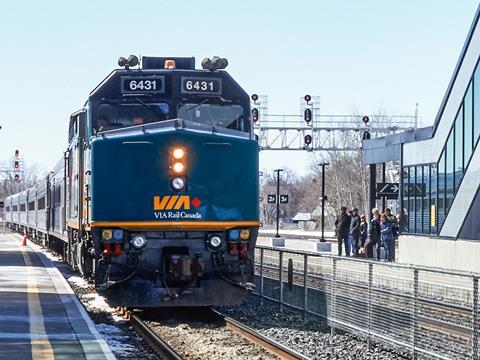
CANADA: The government has announced the start of procurement for the High Frequency Rail programme to build dedicated tracks for 200 km/h electric passenger trains on the Corridor route linking Toronto, Ottawa, Montréal and Québec.
On July 6 Transport Canada said the process to select a private partner for the country’s largest transport infrastructure project in decades would to begin with a request for proposals later this year.
Transport Minister Omar Alghabra told media the project could cost C$6bn to C$12bn depending on the scope, with completion envisaged for 2030.
The announcement came as speculation mounted about the possibility of an election being called this year.
Dedicated tracks
Inter-city train speeds, frequencies and performance on the Corridor are currently constrained by the tracks being shared with freight services. National passenger operator VIA Rail put forward an initial concept in 2016 for upgrading the route. Since then it has been working with Transport Canada, Infrastructure Canada, Finance Canada and Canada Infrastructure Bank to conduct in-depth studies.
The government is providing C$4·4m in 2021-22 to complete analysis and option assessment, and C$491·2m over six years for shorter term infrastructure works which would support the project by reducing existing bottlenecks and improving fluidity.

The aim of the High Frequency Rail programme is to provide more services and raise the maximum speed to 177 or 200 km/h. This is expected to cut up to 90 min from the current Toronto to Ottawa journey time of between 4 h 17 min and 4 h 53 min, increase the proportion of on-time arrivals from 67% to 95%, and improve connectivity between cities and with other modes.
The upgraded route would enable the introduction of new services to communities including Peterborough, Trois-Rivières and Laval, while new stations would be developed including one near Québec’s Jean Lesage Airport.
Electro-diesel locomotives would be used to enable through running over non-electrified lines belonging to the freight railroads. Alternatives such as hydrogen were assessed, but the technology was considered to be insufficiently developed for an inter-city passenger service.
Projections suggest that High Frequency Rail could increase annual ridership in the Corridor from 4·8 million journeys in 2019 to 17 million by 2059.
‘Thousands of commuters will opt for this way of travelling, rather than by car or by plane, as it will be faster, more reliable, economical and environmentally sustainable’, said Jean-Yves Duclos, President of the Treasury Board and Member of Parliament for Québec.
Delivery model
Transport Canada is engaging with the private sector to seek perspectives on the best delivery model, as well as negotiating with freight railways on dedicated routes into the city centres. It is also engaging with indigenous groups and local communities.
Canada Infrastructure Bank CEO Ehren Cory said ‘we look forward to gaining further insight through market engagements with industry experts, rail-sector stakeholders and investors, as we collaborate with the Government of Canada on potential delivery models’. The bank ‘will bring our expertise in leveraging public, private and institutional investment to support the next steps to modernise inter-city passenger rail.’
‘Since proposing High Frequency Rail more than five years ago, VIA Rail has been working tirelessly to ensure it becomes a reality’, said the operator’s President & CEO Cynthia Garneau. ‘It is time to provide Canadians with a nation-building, growth-generating and environmentally friendly project which will transform the way present and future generations live and travel.’

















